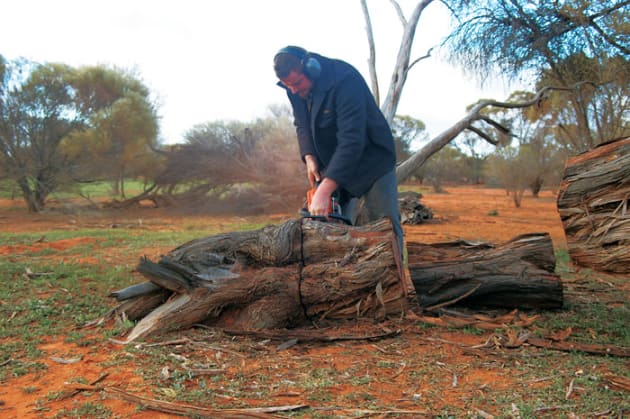Desert Timber Trip
 Words: Pete McCurley
Words: Pete McCurley
Photos: Pete McCurley, Daniel Rechter
As both a woodworker and a lover of the Australian landscape I like to directly source wood from private land, state forests and just about anywhere I can get permission and cause minimal harm. There are few places that afford the space and freedom to do this better than the expanse of the Australian outback.
When the slush and mud surrounding my workshop started to freeze at night, it signalled the time for a mid-winter adventure. While ice on the outside of a swag is a common arid inland winter experience, so too are bright, clean, clear sunny days, perfect for drying out a July Melbournian.
Only with care
Now that I’ve got you excited at the prospect of going out and cutting bushwoods it’s timely to add a few words of caution. Aside from the obvious personal cost and danger in driving long distances on poor roads and operating chainsaws in remote places, there is the damage that an unscrupulous timber cutter can do to the land.
Durability of a timber is generally linked to longevity of the tree and many desert hardwoods are famously durable. Desert timbers are notoriously slow-growing. Although there is usually an absence of annual growth rings that can be read for age, there is strong anecdotal and sometimes physical evidence of longevity. A good example is the Poole tree, west of Milparinka in the ‘corner country’ of NSW.

The blaze on the Poole tree reveals little growth in the last 162 years.
James Poole was second in command in the ill-fated Sturt expedition in search of a fabled inland sea. Poole died of scurvy during a drought enforced stay at nearby Depot Glen and was buried under a beefwood tree (Grevillia striata). Its trunk bears a blaze carved with the inscription ‘J.P. 1845’. In the 162 years since the blaze was cut, the tree has grown only 20–25mm of new wood underneath the bark—a rate of less than 0.2mm per year! At approximately 500mm at breast height (not large for a beefwood), this tree could be conservatively estimated to be over 1500 years old.
So think long and hard before hacking down trees out here. That said, sourcing timber direct from the land can both yield beautiful timber and point one towards a great appreciation of the land these trees grow in. Salvaging wood on private land should only be undertaken with the permission of the property owner. Contact your state forestry department for information about obtaining a craftwood licence on public land.
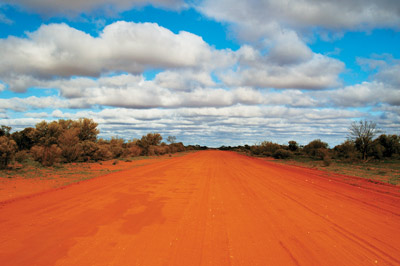
Day 1: Murray River Camp
The seemingly ubiquitous redgum (Eucalyptus camaldulensis) is in all of its great gnarled glory here. Redgum, in its opportunistic adaptability, was never far away on this trip. From the 60 metre high, two metre diameter giants of the Murray to the craggy old methuselahs of a desert uplands gorge, redgums were common but anything but plain. Of course the same can be said of their wood.
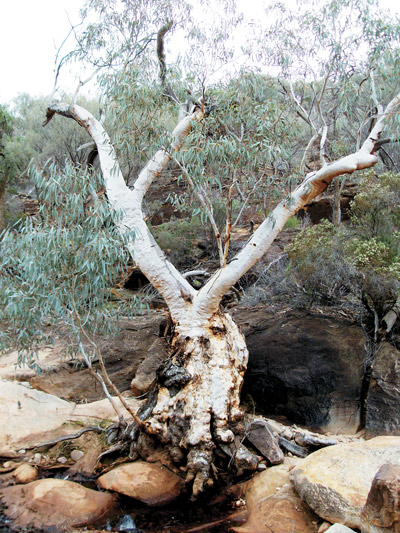
Dry bed river redgum
Growing alongside the redgums were black box (Eucalyptus largiflorens) leaning long out over the high banks. Stands of river cooba or eumong (Acacia stenophylla) filled in the forest mid-storey with a grassland groundcover.
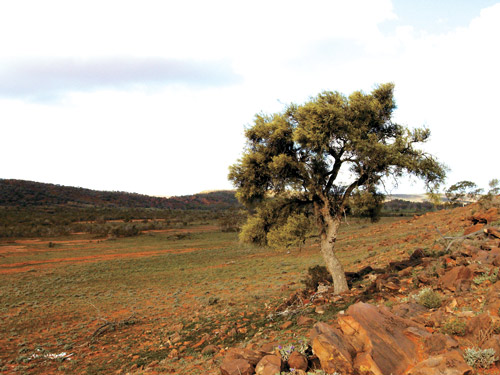
Acacia loderii (nelia or nealie) grows 3–8 metres high in inland NSW and parts of SA and Victoria.
On the way heading north was the first stand of boonaree (Alectryon oleifolious), silver green on a red sandy rise. Boonaree (other common names include desert, inland or western rosewood has a startling red and black, dense, streaky heartwood. Unfortunately the heartwood is generally small, and nearly always full of faults. For small-scale use however it is comparable to if not prettier than Macassar ebony.
Day 2: Belah camp
For many miles the rolling hills north of the Murray are clad in dense belah (Allocasuarina cristata) woodlands. Warmed by glowing fires we watched the Milky Way arch across the night sky as wind sang through the belah trees.
It seems strange to me that belah is not more highly regarded as a craftwood. This may be because, unlike other Casuarinas, it doesn’t have distinctive oak-like medullary rays. The rays of belah are reduced in prominence to a fine flecking, as in myrtle beech. The timber is however a beautiful dark walnut colour and takes a high polish. It grows to a fairly substantial tree and is prone to the range of grain disfigurements that produce highly figured timber. And yes it is also mighty fine firewood.

Native cypress (Callitris sp.)
The belah woodland also contained sugarwood (Myoporum platycarpum) also known as false sandalwood. This has wood which is a kind of cross between native cypress (Callitris sp.) and sandalwood (Santalum sp.), being mid-brown and highly fragrant.

Sandalwood (Santalum sp.)
Another tree growing here is wilga (Geijera parviflora), distinguished from sugarwood only by the faint toothing of the leaf edges. Wilga wood is like sugarwood except for its (usually narrow resinous) dark brown to black heartwood.
Day 3: Desert Rangelands
A couple of trees of particular interest were found here. Dead finish (Acacia tetragonophylla) is a wild little steel-boned bush of up to four metres high and sometimes more across. Though small sized, it’s probably the toughest, hardest and heaviest timber that I have worked. Its colour is best likened to a flame or sunset orange that is figured, has the depth of tiger’s eye, and is so hard that it will burnish like polished stone.
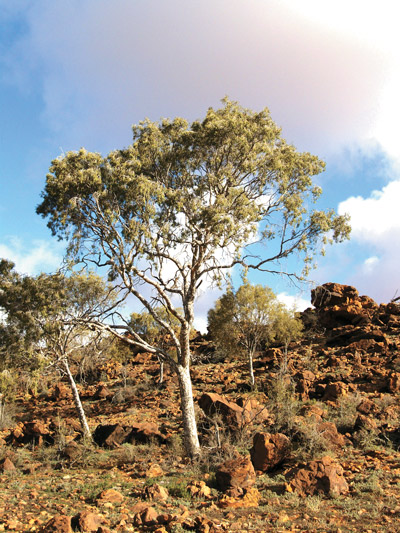
Leopardwood (Flindersia maculosa).
For years I’ve been seeking the elusive ‘ringed’ dead finish. Ringed refers to a rare growth habit in some trees where the entire tree, often through to the branches, displays a radial crimping of the wood fibres. Entire trees of fiddleback! This trip I brought home a good desert-dry little trunk with fiddleback finely crimped as the best merino wool.
Another desert shrub of striking character is the magenta emu bush (Eremophila alternifolia) also called narrow-leaved fuchsia bush. These remind me of fine bonsai—venerable forest giants standing barely six feet tall. Predominantly found in arid zones, the genus name Eremophila means ‘desert loving’, from the Latin.
Day 4: Gidgee Camp
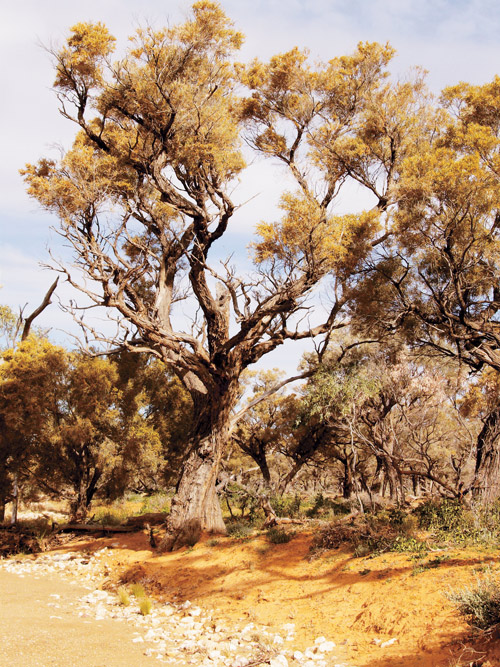
Gidgee or stinking wattle (Acacia cambagei), by desert standards a mid-sized tree, is a woodland and riparian zone species of inland Australia, most common in Queensland and north-western NSW. While valued for fence posts and firewood, gidgee is better known for its pungent aroma (particularly when in flower) than for the beauty of its timber.

Some gnarly figured gidgee.
Gidgee wood is very dense, chocolate brown in colour and, when figured or ringed, highly lustrous. Some beautiful old growth gidgee with trunks over one metre diameter at breast height was found. We collected two logs 450mm diameter or so of blister figured and ringed gidgee as well as lots of lovely smaller blocks and billets.
The best fallen tree found was on some flats, just up from the main channel of a shaley riverbed. After this year’s heavy rainfall the tree was nicely half buried in alluvial sand. Anything you cut in the desert is full of sand, so you soon get used to sharpening your saw every few cuts—but this log was really dirty.
We had to dig a couple of channels under the log, brush these areas down with a good firm brush and then put the saw through only where it was clean. Upon levering the log out, it was found to have only a small pipe of mudguts (termite residue) up the middle with the rest of the wood perfect. Many cubic feet of dark, blister figured gidgee, ready for the bandsaw mill to convert to instrument timbers, inlays, knife and tool handles, fine furniture components—this is very pretty wood.
Pete McCurley cutting a large fallen nelia tree.



 Words: Pete McCurley
Words: Pete McCurley